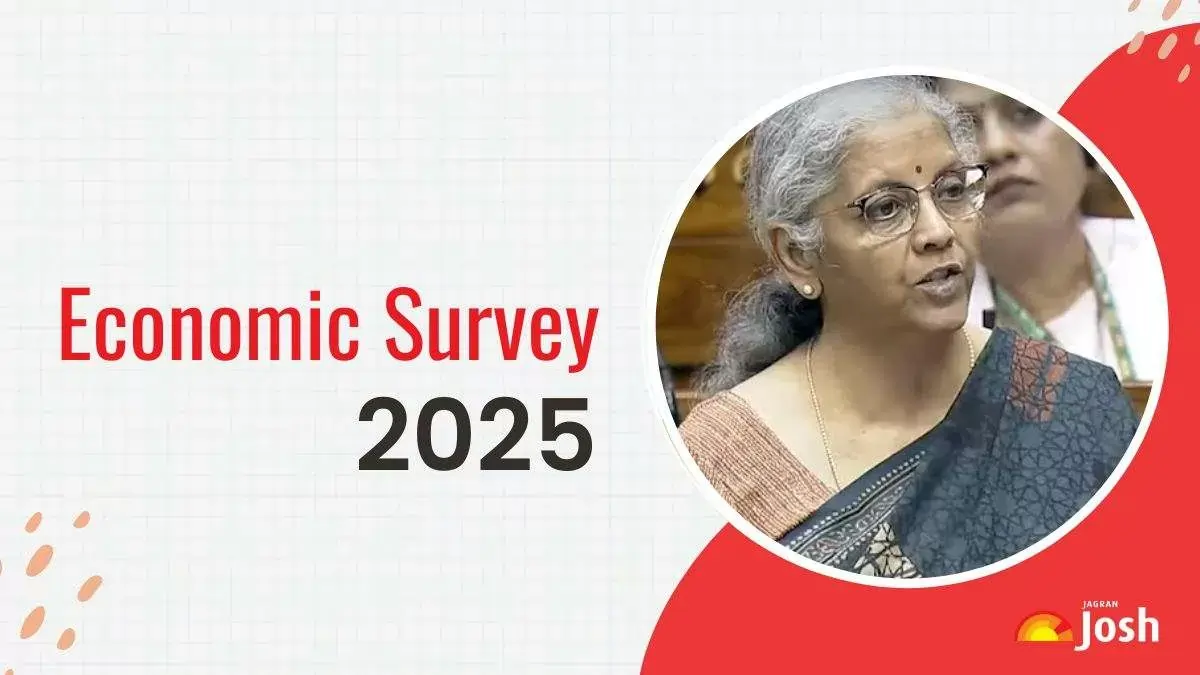The Economic Survey 2025 offers a detailed examination of India’s current economic situation and lays out the roadmap for future growth. With a focus on addressing post-pandemic challenges and global uncertainties, the survey highlights the resilience of India’s economy and underscores the policies needed to accelerate development. The Economic Survey provides a backdrop for the Union Budget, guiding the government in framing fiscal policies.
The Economic Survey 2025 delves into key economic indicators, sectoral performance, fiscal measures, and emerging challenges, while also suggesting reforms to sustain growth and improve the quality of life for the population.
Economic Growth Projections
One of the primary aspects of the Economic Survey 2025 is the projection for Gross Domestic Product (GDP) growth. The survey forecasts India’s real GDP to grow between 6.3% and 6.8% in 2025-26, marking a modest increase from the previous year’s 6.4% growth. This optimistic projection signals India’s recovery from economic slowdowns induced by the pandemic, global supply chain disruptions, and inflationary pressures.
The government emphasizes rural demand revival, agricultural productivity, and infrastructural development as the primary drivers of growth in 2025. Additionally, favorable macroeconomic conditions and fiscal discipline will play a vital role in sustaining this upward trajectory. However, the survey also points out risks like global geopolitical tensions, volatile oil prices, and external economic shocks, which could dampen growth prospects.
Inflation Trends and Monetary Policy
The Economic Survey 2025 highlights inflation as a critical challenge. Retail inflation, which had been a concern over the past couple of years, has begun to ease. By the end of 2024, inflation rates had reduced to around 5.2%, providing some relief to households and businesses. Despite this, food inflation, primarily driven by vegetable prices, continues to pose a challenge.
The Reserve Bank of India (RBI) has taken a cautious approach by maintaining a stable monetary policy, ensuring that inflationary pressures do not erode purchasing power or investment sentiment. The Economic Survey 2025 stresses the importance of maintaining price stability while promoting growth. The government aims to strike a balance between growth and inflation control by tweaking fiscal and monetary policies accordingly.
Employment and Labor Force Participation
India’s labor market dynamics play a crucial role in determining economic health. The Economic Survey 2025 emphasizes the need to generate more employment opportunities, particularly in the formal sector. Although government data suggests a drop in the unemployment rate to 3.2%, independent surveys suggest it could be as high as 8.05%.
The Economic Survey 2025 identifies the need for labor market reforms, particularly in sectors such as agriculture, manufacturing, and services. It also highlights the significance of female labor force participation, which remains lower than expected. Removing restrictions on female workers in certain industries and promoting gender inclusivity in the workplace can provide the necessary impetus to the labor market.
Fiscal Deficit and Debt Management
A crucial theme of the Economic Survey 2025 is fiscal consolidation. The survey notes that the government remains committed to reducing the fiscal deficit and managing public debt efficiently. The fiscal deficit for 2025 is targeted to remain under 4.9% of GDP. This fiscal discipline is essential to maintain investor confidence and ensure that borrowing costs remain manageable.
India’s debt-to-GDP ratio remains at 82.6% as of 2024-25. The government intends to bring this down in the upcoming years by focusing on revenue generation, curbing non-essential expenditures, and boosting tax compliance. The Economic Survey 2025 emphasizes the need for reforms in the tax structure to improve collection efficiency without burdening taxpayers excessively.
Foreign Direct Investment (FDI) and External Sector
The Economic Survey 2025 reflects on the dip in Foreign Direct Investment (FDI) inflows. From April to November 2024, net FDI inflows stood at a modest $479 million, a significant drop from the $8.5 billion recorded during the same period in 2023. This decline has been attributed to several factors, including outbound investments by Indian companies and a cautious global investment climate.
The survey underscores the importance of creating an investor-friendly environment by simplifying regulatory frameworks, improving ease of doing business, and ensuring policy stability. India’s strong demographic dividend, robust consumer market, and growing technology sector make it an attractive destination for FDI. The Economic Survey 2025 calls for strengthening ties with key trading partners and exploring new markets to enhance FDI inflows.
On the trade front, India’s exports have faced headwinds due to slowing global demand, while imports have risen due to elevated oil prices. The trade deficit widened to $210.77 billion, but the current account deficit showed a slight improvement, narrowing to 1.2% of GDP. The Economic Survey 2025 emphasizes the need for export promotion strategies, diversification of markets, and reducing dependency on a few key commodities.
Sectoral Performance: Agriculture, Manufacturing, and Services
The Economic Survey 2025 takes a deep dive into the performance of key sectors—agriculture, manufacturing, and services. Agriculture remains a cornerstone of the Indian economy, employing nearly half the workforce. The survey highlights the importance of a normal monsoon, improved irrigation facilities, and the adoption of technology to boost agricultural productivity. Additionally, measures like crop insurance and farm mechanization are crucial for ensuring rural prosperity.
The manufacturing sector has shown signs of recovery, particularly after grappling with challenges such as high input costs and supply chain disruptions in previous years. The government’s focus on initiatives like “Make in India” and the production-linked incentive (PLI) schemes has begun yielding results. The Economic Survey 2025 stresses the need for further simplification of regulations, availability of credit, and the enhancement of skill development programs to sustain growth in this sector.
The services sector, which accounts for more than 50% of India’s GDP, continues to be a major growth driver. The survey notes the rise of the digital economy, IT, financial services, and telecommunications as prominent contributors to this sector’s growth. The expansion of infrastructure and construction, driven by government investments, has also boosted job creation and economic activity in the services sector.
Public Policy and Governance Reforms
The Economic Survey 2025 lays great emphasis on the role of governance reforms in achieving long-term economic goals. Deregulation remains a key policy focus, as the government seeks to remove unnecessary bureaucratic hurdles that stifle innovation and job creation. The survey identifies several sectors where deregulation can have an immediate positive impact, including small and medium enterprises (SMEs), the labor market, and financial services.
The Economic Survey 2025 also advocates for an institutionalized system for assessing the impact of regulations. Financial regulators, in particular, should have a formal process to evaluate how their rules affect businesses, consumers, and the economy at large. The report highlights the need for transparency, objectivity, and accountability in regulatory practices, which would improve governance and promote trust among stakeholders.
Infrastructure Development and Digital Transformation
Infrastructure development remains one of the central pillars of India’s economic strategy, as highlighted by the Economic Survey 2025. Investments in roads, railways, ports, airports, and urban infrastructure have played a pivotal role in boosting the economy and creating employment. The survey emphasizes the need for continued investments in smart cities, green energy, and logistics to maintain this momentum.
Moreover, digital transformation is another critical theme in the Economic Survey 2025. The rapid adoption of technology, spurred by initiatives like Digital India, has transformed sectors such as banking, healthcare, education, and governance. The survey suggests enhancing digital literacy, ensuring affordable access to technology, and promoting innovation through public-private partnerships to sustain this digital revolution.
Sustainability and Climate Change Mitigation
The Economic Survey 2025 underlines the growing importance of sustainability and climate resilience in shaping India’s economic policies. The government’s commitment to achieving net-zero emissions by 2070 and expanding renewable energy capacity has been widely recognized. The survey calls for accelerated investments in clean energy, afforestation, and green technologies to combat climate change.
Furthermore, the Economic Survey 2025 discusses the potential of the circular economy, which focuses on reusing, recycling, and reducing waste. This model not only promotes environmental sustainability but also generates new economic opportunities in sectors like waste management, energy efficiency, and sustainable agriculture.
Conclusion: A Path Forward
The Economic Survey 2025 provides an in-depth analysis of India’s economic strengths, challenges, and opportunities. It offers a comprehensive blueprint for sustainable and inclusive growth in the coming years. The government’s commitment to fiscal discipline, employment generation, infrastructure development, and digital transformation will be critical in realizing these objectives.
As India continues to navigate global uncertainties, the reforms outlined in the Economic Survey 2025 will serve as a guide to foster resilience and long-term prosperity. By prioritizing inclusive growth, fostering innovation, and investing in sustainability, India can unlock its true economic potential and become a global powerhouse in the 21st century.



